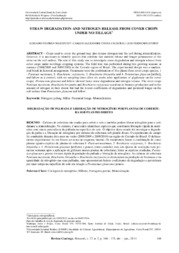Straw degradation and nitrogen release from cover crops under no-tillage.
Straw degradation and nitrogen release from cover crops under no-tillage.
Autoria: NASCENTE, A. S.; CRUSCIOL, C. A. C.; STONE, L. F.
Resumo: Crops used to cover the ground may also release nitrogen into the soil during mineralization. However, it is necessary to identify species that combine fast nutrient release and longer permanence of the straw on the soil surface. The aim of this study was to investigate straw degradation and nitrogen release from cover crops under no-tillage cropping systems. The field trial was performed during two growing seasons in summer (2008/2009 and 2009/2010) in the Cerrado region of Brazil. The experimental design was a randomized block in factorial arrangement. Treatments were the combination of five plants (four cover crops species, 1 - Panicum maximum, 2- Brachiaria ruziziensis, 3. Brachiaria brizantha and 4. Pennisetum glaucum [millet], and fallow as a control) with six sampling times (first six weeks after application of glyphosate on the cover crops). Pennisetum glaucum and fallow showed faster straw degradation and nitrogen release. The cover crops Panicum maximum, Brachiaria brizantha and Brachiaria ruziziensis stood out in biomass production and in the amount of nitrogen in their shoots but had the lowest coefficients of degradation and persisted longer on the soil surface than Pennisetum glaucum and fallow.
Ano de publicação: 2014
Tipo de publicação: Artigo de periódico
Unidade: Embrapa Arroz e Feijão
Palavras-chave: Milheto, Nitrogênio, Palhada, Planta de cobertura, Planta forrageira, Plantio direto
Observações
1 - Por padrão são exibidas publicações dos últimos 20 anos. Para encontrar publicações mais antigas, configure o filtro ano de publicação, colocando o ano a partir do qual você deseja encontrar publicações. O filtro está na coluna da esquerda na busca acima.
2 - Para ler algumas publicações da Embrapa (apenas as que estão em formato ePub), é necessário ter, no celular ou computador, um desses softwares gratuitos. Sistemas Android: Google Play Livros; IOS: iBooks; Windows e Linux: software Calibre.
Acesse outras publicações
Acesse a Base de Dados da Pesquisa Agropecuária (BDPA) para consultar o acervo completo das bibliotecas da Embrapa.

